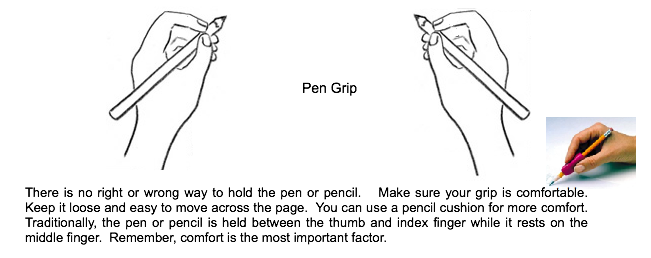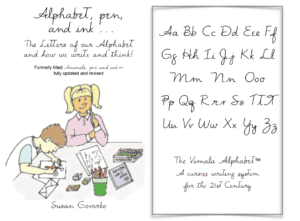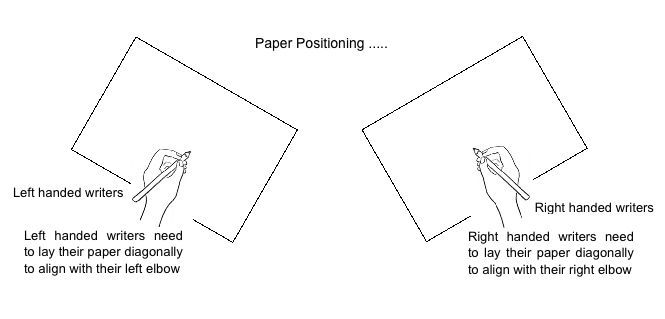Homeschooling and the Art of Reading and Writing
Dual aspects of the communication process

A natural impulse to write
What makes us write? What is it that causes a kid to doodle circles on foggy windows or write “wash me” in the scum on a dirty car?
Give a toddler a box of crayons or markers and stand back; she will scribble, draw or fill in a whole page without any prompting from anyone. It’s instinctive.
Add form to that movement across the page and we have letters that make up words and words that make up sentences and sentences that tell a story.
From the very beginning when a baby first wraps her fingers around an adult finger, looking up and holding a firm grasp, there is a connection between hand and brain. It’s important to foster this connection and strengthen the fine motor skills that allow a pre-schooler to draw, color, paint, build with various shapes and kinds of blocks, legos, tinker toys, string beads, and thread sewing cards. Make learning fun. Make organization fun. Sorting shapes and colors can be a game to organize and put away toys after play. Counting seeds and transferring them into trays. All these activities support fine motor skills used in handwriting.
Reading to your child from an early age is paramount to building a lifelong love of learning. Reading together offers wonderful clues to your child’s interests and talents. And reading fosters the desire to learn to write, to spell, to compose words and stories.
Writing is to Speaking as Reading is to Listening
There are many approaches to handwriting. One that works well is a coordinated presentation of the letters in reading and writing together. Reading and writing are really two sides of the same process, a conversation or interchange of ideas. A means of discussion or dialogue. Engage the process by presenting letters and reading words through handwriting.
Establishing the firm concept of a letter as a ‘sound-symbol’ is foundational to teaching the integral process of reading and writing. In his definitive book, Samuel Blumenfeld (Alpha-Phonics) outlines a well thought out approach to introducing the letters in an order that allows the young child to adapt to phonetic reasoning and spelling. Reading and learning to write simultaneously provides a well integrated approach to building a successful skill set for literacy.
The purpose of writing is clear, legible communication, not perfection. In the beginning, practice is essential in establishing a comfortable familiarity in forming the letters. Handwriting is personal, and teaching handwriting needs to be accompanied by lots of patience and plenty of praise sprinkled in to every learning session. “Good job!” “That’s a wonderful Letter!” “You’re doing so well!” “Looking good!” Any corrections need to be gentle, “Try it this way,” or “Can you add a garland here,” or “Will this letter stretch just a bit taller,” etc. Follow the child’s efforts with praise. Learning to write is a big undertaking for a young child.
Typically a handwriting system is chosen as a model to emulate. The Vimala Handwriting System™ is the one we use. It is the most advantageous cursive writing system. There is no need to teach print writing. It’s much easier and less confusing to teach young children cursive from the very beginning.
The fundamental basics of handwriting
Pen grip, paper position, form and connectivity are the beginning elements to consider when teaching a child to write. The pen grip needs to be comfortable and the pencil or pen needs to fit the hand so that there is flexibility and freedom for moving easily as the letters are formed.

A blank page presents us with space to order our writing: margins, baselines for the letters and words, and paragraphs will emerge from writing. At first, beginners‘ letters tend to be large as they develop their fine motor skills. Movement and form in handwriting consists of soft curved strokes and straighter angle strokes. Over time, with consistent practice, form and spacing become much more fluent.
Organize materials before you start your lessons
- magnetic white board and dry erase pens

- paper and pens (pencils for the very young)
- magnetic letters
- The Vimala Guidebook –Alphabet, pen and ink– (and / or printouts of the Vimala Alphabet)
- Alpha-Phonics word lists (written out or printed with the Vimala Alphabet)
- Bob books (and / or other early readers)
- Patience, patience patience!!
Organize your mood!
Three deep breaths – breathe deeply, into your tummy and let go
Humor, smiles, enthusiasm, lightheartedness, lots of praise
Getting started
Have pen / pencils, paper (unlined), and a clean writing area organized before starting any writing practice. Paper position is most important. This is especially true for left-handed children. Make sure the paper is aligned with their dominant writing hand’s elbow. (See illustration) Check the pencil / pen grip also, making sure the hand is relaxed so that the writing instrument rests gently on the middle finger, gripped between the thumb and first finger (pointer finger). There is about a 3/4 to 1-inch space from the tip of the first finger to the pen tip. Pencil cushions may make the process more comfortable.

Teaching Cursive – Link to pages for appropriate age / skills level
Link to specific pages for the Beginning writer (Pre-K – K), Established readers (Elementary Grades), Tweens and Teens, or Adult Learners. Additionally, the Student Guides page includes some helpful downloads, and our Book Nook page has some reading suggestions.
If you are new to the Vimala Alphabet™ and would like to write along with your teenager, check out some of the suggestions on the writing for Personal Growth page.
Link to downloadable Tutor’s Handbook, Teaching the Vimala Alphabet™ – A Tutor’s Handbook, and companion guide to the illustrated guidebook, Alphabet, pen and ink! The Tutor’s Handbook is only available as a download from this website.
Online classes
It’s important to establish routine consistency
Establishing a regular daily practice is most important. The length of time can be minimum, fifteen to twenty minutes, however maintaining a consistent routine is essential. Same place and time. Consistency is key. During the time allotted to writing, write along with your child / children. Plan a fun activity or snack time to enjoy immediately after your writing practice sessions. Avoiding the ‘reward’ mindset, rather choose this as a time of ‘celebration.’ Celebrate your child’s success!
Again, Remember:
The key is regular, consistent daily practice!
By the yard, it’s hard! By the inch it’s a cinch!
Just 15 minutes a day, every day

